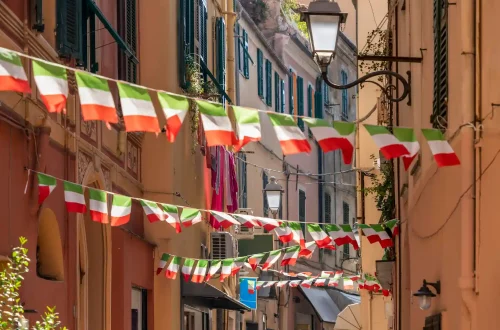Introduction to Italian culinary traditions
In Italy, food is a way of life. From bustling city markets to quiet village kitchens, the act of preparing and sharing a meal is deeply woven into the fabric of Italian culture. It reflects not only regional identity and historical legacy but also the social values that bind families and communities together.
Italian cuisine is a source of national pride, celebrated for its simplicity, freshness, and reverence for tradition.
Loved around the world, Italian food is often reduced to pizza and pasta in popular imagination. But beneath these global icons lies a rich and diverse culinary landscape shaped by geography, climate, and centuries of cultural exchange. Italy may be no larger than the state of California, but its 20 regions each boast distinct flavors, techniques, and specialties.
Regional culinary traditions: North vs. South
One of the most fascinating aspects of Italian gastronomy is the stark contrast between the culinary traditions of the North and South.
- North: Northern Italian cuisine is shaped by its mountainous terrain and cooler climate, which favor livestock farming and dairy production. Butter, cream, and cheese play starring roles, and dishes tend to be richer and more indulgent. Polenta and risotto often replace pasta as staple carbohydrates, and meats like veal, lamb, and beef are central to many recipes.
Cheese is a cornerstone of Northern cooking, with varieties like Parmigiano-Reggiano, Asiago, Gorgonzola, and Pecorino adding depth and character to countless dishes. Truffles, chestnuts, and porcini mushrooms are prized seasonal ingredients, while cured meats such as prosciutto and salami reflect centuries-old preservation techniques.
- South: In contrast, Southern Italian cuisine embraces the Mediterranean. The warmer climate supports an abundance of fresh vegetables, herbs, and fruits, while the coastline provides access to seafood that features prominently in local dishes. Olive oil replaces butter, and tomato-based sauces dominate the flavor profile.
Southern Italy is the birthplace of pizza, with Naples claiming the original Neapolitan style—thin, chewy crust topped with tomatoes, mozzarella, and basil. Other regional favorites include eggplant parmigiana, seafood pasta, and crusty breads infused with olive oil and herbs. Anchovies, sweet sausage, and sun-ripened produce are staples that define the Southern palate.
Take advantage of specialized assistance to secure your passport for a borderless future.
Traditional dishes and their origins
Italian cuisine is built on iconic dishes that have transcended borders, yet each has a story rooted in place and tradition.
- Pizza: Originating in Naples–at least the modern version, pizza began as street food. Its transformation into a global phenomenon is a testament to the power of simple ingredients—tomatoes, mozzarella, and dough—combined with culinary passion.
- Pasta: With hundreds of shapes and sauces, pasta is Italy’s most versatile dish. Handmade varieties like tagliatelle and orecchiette reflect local customs, while industrial production has made pasta a pantry staple worldwide.
- Risotto: A creamy rice dish from Milan, risotto showcases Northern Italy’s love for butter and cheese. Cooked slowly with broth and often enriched with saffron, mushrooms, or seafood, it’s a comforting and elegant meal.
These dishes have evolved over time, adapting to modern tastes while preserving their regional roots. Their global popularity speaks to the universal appeal of Italian cooking.
The role of family and celebrations
In Italy, food is inseparable from family and festivity. Mealtime is a cherished ritual, often involving multiple generations gathered around the table. Sundays are reserved for long lunches, and holidays are marked by elaborate feasts.
- Christmas Eve: Traditionally celebrated with a seafood-based meal known as La Vigilia, featuring dishes like baccalà (salted cod) and fried calamari.
- Easter Lunch: Lamb, artichokes, and sweet breads like colomba are staples of this springtime celebration.
- Sunday Gatherings: A weekly tradition where families share homemade pasta, roast meats, and desserts, reinforcing bonds and honoring heritage.
These meals are more than nourishment—they’re expressions of love, memory, and identity.
Influence of the Mediterranean diet
Italian cuisine is a cornerstone of the Mediterranean diet, which emphasizes whole grains, fresh produce, healthy fats, and moderate consumption of meat and dairy. Numerous studies have linked this diet to reduced risk of heart disease and increased longevity.
Key principles include:
- High intake of vegetables, legumes, and fruits.
- Use of olive oil as the primary fat.
- Moderate consumption of fish and poultry.
- Limited red meat and processed foods.
- Wine in moderation, often enjoyed with meals.
Take advantage of specialized assistance to secure your passport for a borderless future.
Food protection laws and culinary heritage
Italy takes its culinary heritage seriously, with legal frameworks designed to protect traditional products and methods. Denominations such as DOC (Denominazione di Origine Controllata), DOP (Denominazione di Origine Protetta), and IGP (Indicazione Geografica Protetta) ensure authenticity and quality.
Examples Include:
- Parmigiano Reggiano: Must be produced in specific provinces using traditional techniques.
- Prosciutto di Parma: Cured in the Parma region with strict guidelines.
- Chianti Wine: Protected by DOC regulations to maintain regional integrity.
These laws preserve Italy’s gastronomic legacy and support local economies, ensuring that future generations can enjoy the same flavors and traditions.
Global cultural impact of Italian cuisine
Italian food has become a global ambassador of culture, influencing culinary traditions from São Paulo to San Francisco. In the U.S., Italian-American cuisine has evolved into its own genre, with dishes like spaghetti and meatballs and chicken parmigiana becoming household staples.
In Brazil, Italian immigrants brought recipes that merged with local flavors, creating unique hybrids like pizza paulista. Italian cuisine is more than a menu—it’s a cultural force, a symbol of identity, and a celebration of life.






